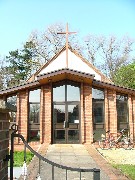| |
St Helen,
Hoveton
 |
|
Hoveton
down by the river is part of the hellish tourist
blackspot of Wroxham, but this clean-lined modern
church sits out on the Coltishall road, almost
opposite Hoveton and Wroxham railway station. As
usual in East Anglia, the response to the needs
of local Catholics in the form of new church
buildings came in the early sixties, just as
discussions in Rome at the second Vatican Council
were changing the shape of liturgical spaces
forever. If it had been built ten years later, it
would probably have been quite different. The
sanctuary is rather traditional, and the curious
asymmetrical organ on the south side is helpfully
matched by decoration on the north. There is a
large galilee porch, with a glass screen across
the body of the church.Although St Helen probably
has the single largest congregation of any church
in the Wroxham and Hoveton area, it isn't
actually a parish church at all, being served as
a chapel of ease from North Walsham. As such, it
is kept locked, and is therefore a source of
considerable annoyance to the likes of me who
thinks that Catholic churches should be kept open
if they are to fulfill their proper liturgical
function.
|
| What
on earth is the point of reserving the blessed
sacrament if the faithful are to be locked out of
its presence? I sound like I am
complaining. In fact, I arrived just as they were
opening up for the Saturday evening vigil Mass,
and the people I met were exceptionally friendly
and welcoming, showing me around, telling me the
history of the place, almost convincing me to
miss my train so I could attend Mass, and
certainly making it impossible to fit in nearby
Hoveton St Peter on this trip. They showed me the
plans for their expansion, a doubling in size of
the church to accomodate their ever-growing
congregation, in the form of an extension to the
south, making the church L-shaped about the
sanctuary.
|
|
 |
They also
had a good moan about the Bishop, something I experience
again and again when visiting East Anglian Catholic
churches at present. Bishop Michael has jumped in with
both feet, and his consultation exercise Forward and
Outward Together has put the future of outstations
like this in doubt. This seems insane; East Anglia is one
of the fastest growing Catholic dioceses in western
Europe, with congregations on the up almost everywhere.
However, the exercise is intended to address the
impending rapid decline in the number of Priests in the
Diocese. How silly. As far as I can see, the situation
makes the case for married and women Priests stronger
every time I think about it.
Simon Knott, April 2005
Postscript: In March 2006,
I received a communication from Father Mark
Hackeson, Private Secretary to the Bishop of
East Anglia, Michael Evans. He writes: You state that
the Bishop's Diocesan Pastoral Plan puts the future of
outstations in doubt. Whilst this may be true of some
such churches, it is clearly not true of St. Helen's,
which as you yourself point out already has plans in
place for an expansion. I must also admit to being
somewhat upset by your attitude to the Diocesan policy as
laid down in the Diocesan Pastoral Plan. Some of your
comments, particularly those personal to the Bishop, seem
to me to be rather ill-informed, to an extent that they
are simply opinionated rather than objective. As you
rightly point out, Diocesan policy (arrived at after
extensive consultation with both laity and clergy) seeks
to address the current shortage of priests. One of the
principal aims is to ensure that every Catholic parish
has its own Parish Priest and access to Sunday Mass. This
has meant in some places looking at the possibility of
closing or moving Mass centres to take account of
population movement and growth, and also the greater
mobility of most Catholics. Many of our Mass centres were
established before most people had access to their own
car (or a lift from fellow parishioners). However, in
other places it involves looking at expanding present
buildings (as at Hoveton, Poringland, St. Laurence's,
Cambridge and elsewhere), or replacing them with new,
larger churches (as at Diss, St. Boniface, Hellesdon,
Norwich and elsewhere), so that the whole community can
meet to celebrate Sunday Mass together - which of course
is not only a "noble aim" of Bishop Evans, but
very much in line with the theology of the Sunday Mass.
You state that you find the Diocesan policy
"silly" and suggest, despite your statement in
the entry for Harleston, that it merely is designed to
address the decline in the number of priests in our
growing Diocese. Such a suggestion is untrue - the
desirabililty of gathering all of the Faithful together
to celebrate one parish Sunday Mass arises much more
fundamentally from the nature and function of the Sunday
Mass. It is something to which we should be moving, even
if the number of priests were to rise (as I am sure it
will).
|
